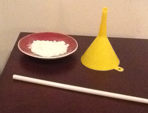 Introduction
Introduction
Flour is an ingredient that is found in most kitchens and used regularly for baking and cooking. Consequently, it is considered safe, and people do not regard the potential hazards. In reality, flour and dust explosions are extremely dangerous, and reducing the risk of such an explosion is a major concern to the agriculture and food processing industries.
The purpose of this demonstration/activity is to illustrate the importance of being aware of potentially harmful situations and practices in the workplace. In particular, the dustiness of a material can affect the nature of chemical reaction, affecting a safe working environment.
How does it work?
Flour is combustible. When sitting as a stable pile the fuel (flour) is more connected to other flour particles than oxygen particles. As dust, each dust particle is surrounded by oxygen particles. This supports the combustion of the flour particle. As each particle moves through the flame, the combustion moves with the particles. Flour explosions tend to be connected to the movement of flour through air. The source of ignition is often discovered to be a static discharge.

 Introduction
Introduction